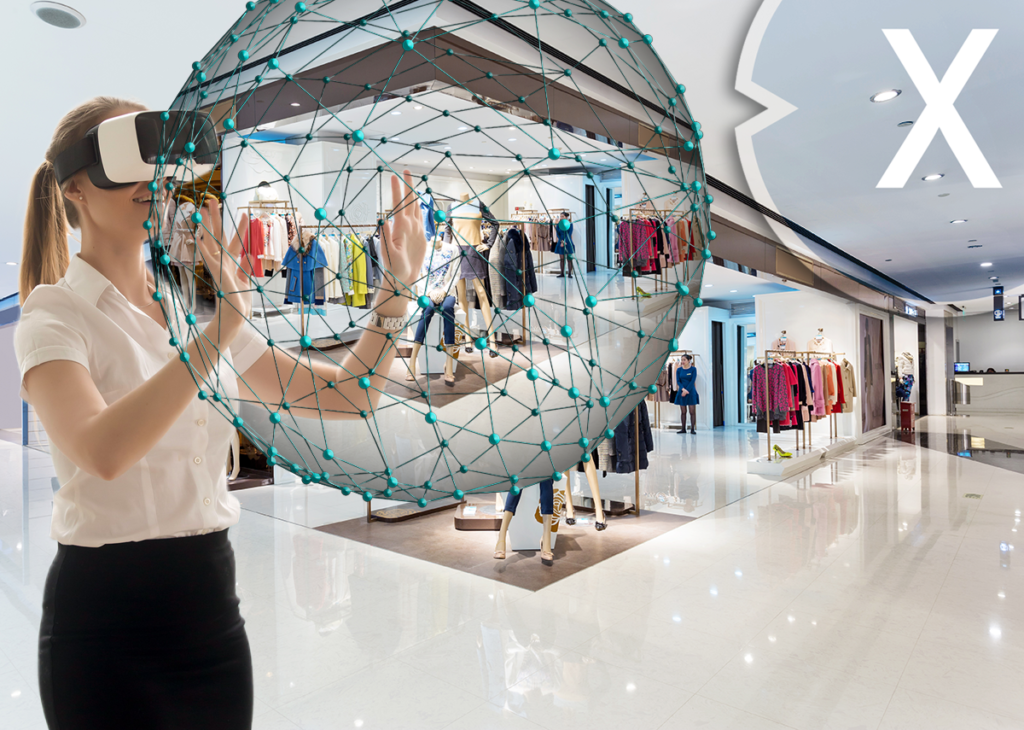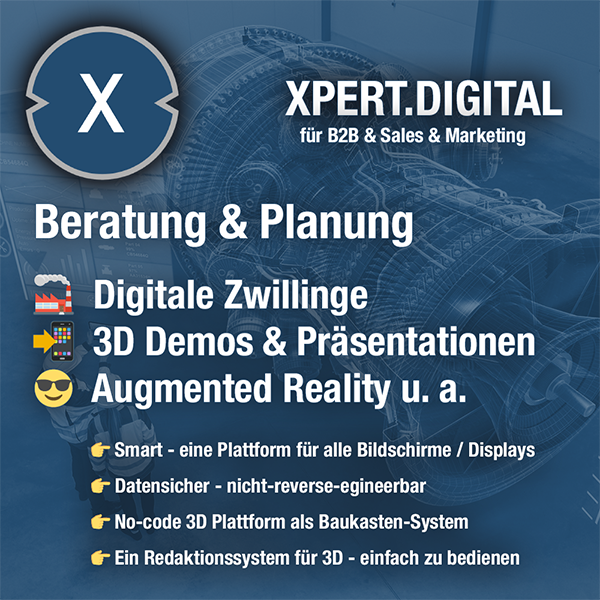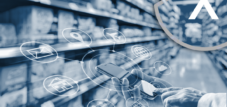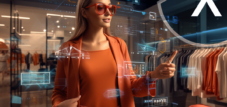XR & Metaverse Gateway Technologies 2024: 2D Matrix Code, WebAR or WebXR and Blockchain Technology – Use for V-Commerce
Language selection 📢
Published on: October 1, 2023 / update from: August 30, 2024 - Author: Konrad Wolfenstein
🌐 The Augmented Worlds Revolution: Gateway and XR Technologies
🎭 Understanding instead of condemning: a new look at blockchain, cryptocurrencies and the metaverse
Between misunderstandings and reality 🤔 Skepticism in the digital age – demystifying digital trends
Are you critical or even negative about trending topics such as blockchain, cryptocurrencies, metaverse and other buzzwords of the digital age? Or do you have an unclearly defined picture of these concepts? This attitude could be due to misunderstandings and fragmented information.
The following link might help you develop a more objective perspective on these issues.
More about it here:
This may allow you to consider the challenges and solutions presented in these articles more impartially.
🎯 The transformation of digital worlds
The digital revolution shows no signs of slowing down. With the rise of XR (Extended Reality, which includes augmented, virtual and mixed reality) technologies, the way we experience the world around us is fundamentally changing. But alongside XR, it is primarily the gateway technologies that will usher in the next stage of our expanded worlds and metaverse. These technologies range from sensor technology in the industrial metaverse to 2D matrix codes and WebAR in the consumer sector. In this article we will take a closer look at how these technologies will change our everyday lives.
Suitable for:
- The diversity of opportunities in the digital twin metaverse: A revolution for industry and B2B business
- Digital Twin – Digital Twin: 3D visualization and digital supply chain management
🏭 The Industrial Metaverse and sensor technology
Sensor technology plays a crucial role in the Industrial Metaverse. Sensors collect data from the physical world and transmit it to digital systems. This makes it possible to automate workflows, increase efficiency and ultimately reduce costs. The integration of sensors into the Industrial Metaverse will also open up the possibilities for remote maintenance, real-time monitoring and preventive maintenance.
Suitable for:
🛒 V-Commerce and Consumer Metaverse: The role of 2D matrix codes and WebAR
While sensors dominate in the industrial metaverse, 2D matrix codes and WebAR/WebXR technology are the real stars in the consumer and customer metaverse. By 2027, the 2D matrix code is expected to replace the barcode known from the 1970s worldwide. Why is that important? A 2D matrix code can store more data than a traditional 1D barcode. This means that products can carry more information that can be easily accessed by the end user in addition to global logistics. In addition, WebAR technology enables a much more comprehensive customer experience in online shopping.
More about it here:
🌐 Blockchain and globalization: an unbeatable duo
The combination of 2D matrix codes with blockchain technology has the potential to revolutionize global logistics. Blockchain offers a secure and transparent way to document transactions. In this combination, real-time scanning and verification can significantly simplify and improve the global supply chain.
More about it here:
- It is important to understand that blockchain technology is not just limited to the financial sector
- Use of blockchain technology in global logistics
🌠 Future perspectives: More than just codes and data
The 2D matrix code and similar technologies are more than just tools for trade and logistics. They could also play a role in healthcare, education and many other areas. From tracking drug manufacturing to providing interactive learning materials, the applications are endless.
Suitable for:
📣 Similar topics
- 🏭 Industry 4.0 and the role of sensor technology
- 🛒 The revolution of online shopping through WebAR
- 🌐 Blockchain: The technology behind the logistics of tomorrow
- 🌠 The versatile applications of 2D matrix codes
- 🎯 How extended reality is changing our everyday lives
- 🌐 V-Commerce: The next big thing in e-commerce?
- 🏭 Remote maintenance and preventative maintenance in the Industrial Metaverse
- 🛒 Customer loyalty through augmented reality
- 🌐 Smart contracts in the supply chain
- 🌠 Education and healthcare: New horizons through 2D matrix codes
#️⃣ Hashtags: #IndustrialMetaverse #2DMatrixcode #WebAR. #BlockchainInLogistics #ExtendedReality
Innovations, advice & top tips 🛠️🧠
In 2024, Metaverse Gateway technologies are no longer just science fiction, but an essential part of our everyday lives. These technologies provide access to virtual worlds that can turn our reality upside down. 2D matrix codes, blockchain and WebAR or WebXR play a crucial role.
2D matrix code: The key to the digital world 🏷️🔑
2D matrix code: The bridge builder between the physical and digital world 🌉📲
2D matrix codes are much more than just a barcode system. They are the gateway that connects physical objects to the digital world. For example, they allow easy access to virtual shopping centers or scanning products in real retail stores for additional information. Matrix codes are also crucial for authentication and verification on secure networks.
Application examples 👀
- Linking products: With a single scan you can perform product details, user reviews or even virtual try-on.
- Fast transactions: Payment processes can be significantly accelerated by simply scanning the code.
Blockchain technology: trust and transparency 🛡️🌐
Blockchain technology offers a decentralized, transparent and secure infrastructure that can be particularly useful in the metaverse. It allows users to conduct transactions and interactions in a trusted environment.
Key components 🗝️
- Smart contracts
- Decentralized identity
- Tokenization of assets
WebAR and WebXR: Immerse yourself in virtual reality 🕶️🌌
WebAR (Web Augmented Reality) and WebXR (Web Extended Reality) offer a new level of interactivity and immersion on the web. These technologies make it possible to experience augmented and virtual reality directly in the browser, without additional software or special hardware.
They offer the advantage of being easily accessible and compatible with a wide range of devices.
Application examples 🎮
- Virtual shopping experiences
- Education and Training
- Social interactions
Advice & Top Tips: Optimize your Metaverse strategy 🛠️📈
To get the most out of these gateway technologies, it is important to develop a well-thought-out strategy.
Strategic considerations 🎯
- Target group analysis
- Technological selection
- Privacy and security
📣 Similar topics
Future
of
:
From AR to 5️⃣ Virtual Reality in Healthcare: A Paradigm Shift 🏥🌐
6️⃣ Security in the Metaverse: Authentication and Privacy 🔒🌐
7️⃣ The Metaverse and the Future of Education 🎓🌐
8️⃣ How WebAR is Changing the Way We Shop 🕶️🛒
9️⃣ Immersive Experiences: Like VR and AR are changing tourism ✈️🌐
🔟 The role of AI in the Metaverse 🤖🌐
#️⃣ Hashtags: #Metaverse2024 #2DMatrixcode #Blockchain #WebAR #WebXR
🗒️ If you don't understand something or need advice, we also offer training and workshops

Metaverse & Extended Reality training, lecture or workshop for augmented, mixed and virtual reality – Xpert.Digital
In today's digital era, technology is evolving at a rapid pace. There are constantly new terms and technologies that need to be understood and mastered. If you're having trouble keeping up with topics like Metaverse, XR technologies, or immersive 3D, you're not alone.
More about it here:
🌐 Gateway Technologies: A guide to understanding these key technologies
The concept of gateway technology is complex and plays a crucial role in various areas. These technologies serve as entry or transition points that can pave the way for further technologies and innovations. In this article we look at the diverse applications of gateway technologies in different sectors.
🖧 🖥️ In Information Technology: The Highway of the Digital Age
In IT, gateways often form the interfaces between different networks and thus make communication between them possible. Be it a router that regulates data traffic in the home network or a complex network switch in a company network: gateways are the arteries of the digital world. They are not only responsible for data flow, but also ensure security through firewalls and other protection mechanisms.
🌐 Routers and switches: core components in the network
Routers and network switches are standard devices that act as gateways. They are central to routing data traffic and ensure fast and secure communication between different networks.
📲 Economy and Innovation: The gateway to the digital world
📱 Smartphones: The all-purpose weapon in the digital age
Smartphones are perhaps the most prominent example of a gateway technology in the modern economy. They have paved the way for numerous other technologies, such as mobile apps and mobile payments, and have massively expanded access to digital services.
🌿 Renewable energies: key to a sustainable future
🔋 Lithium-ion batteries and hydrogen storage
These technologies act as a gateway for the widespread use of renewable energy. They enable the storage of energy from the sun and wind and its efficient use at a later date.
🏥 In healthcare: The networking of systems
💻 Software and hardware interfaces
In modern health information systems, software and hardware gateways serve as interfaces that enable smooth communication between different databases and software applications.
🤝 Gateway technologies as pioneers of the future
Gateway technologies are not only key components in their respective industries, but also catalysts for broader social and economic change. They enable innovation and drive progress in various areas.
📣 Similar topics
- The Evolution of Gateway Technology: A Historical Overview 📚
- How gateways are changing cybersecurity 🛡️
- Use of gateway technologies in smart cities 🏙️
- The role of gateways in IoT ecosystems 🤖
- Gateway technologies in the automotive industry 🚗
- Hydrogen: The gateway to clean energy? 🌿
- Blockchain as a gateway technology in the financial sector 💰
- The Future of Gateway Technologies: What's Next? 🚀
- Gateway technologies in telemedicine 🩺
- How small businesses can benefit from gateway technologies 🏢
#️⃣ Hashtags: #GatewayTechnology #Innovation #RenewableEnergy #InformationTechnology #Healthcare
WebAR and WebXR: similarities, differences and areas of application 🌐🤖
What are WebAR and WebXR? 🤔
WebAR (Web Augmented Reality) and WebXR (Web Extended Reality) are technologies that make it possible to experience augmented or mixed realities directly in the web browser. Both technologies have the potential to radically change the way we interact with digital space, but they also have their own specific application areas and technical limitations.
Similarities between WebAR and WebXR 🤝
Platform independence 🌍
Both technologies are platform independent, meaning they work on different devices and operating systems. The advantage here is that developers do not have to develop separate software for different platforms.
Ease of use 🤗
Both WebAR and WebXR do not require any special hardware or software installations. Users can simply visit a web link and immediately immerse themselves in augmented or mixed reality.
Real-time interaction ⏱️
Both technologies enable real-time interactions with digital elements, making them ideal for education, entertainment and other applications.
Differences between WebAR and WebXR 🤷♂️
Areas of application 🎯
While WebAR is primarily used for augmenting the physical world with digital elements, WebXR aims to cover a wider range of experiences, including virtual reality (VR).
Technical requirements 🛠️
WebXR often requires more powerful hardware and specialized sensors for a fully immersive experience, while WebAR typically works with the cameras and sensors of a standard smartphone or tablet.
Standardization and APIs ⚙️
WebXR has a richer API that allows developers to build more complex applications. WebAR is often more limited but easier to implement.
Areas of application: Where are they used? 🏭
Education 🎓
WebAR can be integrated into educational platforms to create interactive learning modules. WebXR even offers the ability to create fully immersive learning environments.
Retail and e-commerce 🛒
WebAR allows customers to see what a product would look like in their own environment, while WebXR can enable virtual shopping experiences.
Healthcare 🏥
WebXR can be used for training medical staff, while WebAR is useful for patient care and information delivery.
What is the future of WebAR and WebXR? 🚀
Rapid developments in AI, machine learning and sensor technology will further expand the possibilities for WebAR and WebXR. They are likely to play a key role in the digital transformation of many industries, offering new opportunities for interaction and engagement.
📣 Similar topics
- 🌐 WebAR: The next revolution on the web?
- 🤖 WebXR: The Path to Total Immersion
- 🤝 Similarities and differences: WebAR vs. WebXR
- 🛠️ Technical challenges of WebAR and WebXR
- 🎓 Education of the future: Use of WebAR and WebXR
- 🛒 How WebAR and WebXR are revolutionizing retail
- 🏥 WebAR and WebXR in healthcare
- ⚙️ Standardization and APIs: The technical framework of WebAR and WebXR
- 🚀 Future prospects: What’s next for WebAR and WebXR?
- 🌍 Platform independence: A blessing for developers
#️⃣ Hashtags: #WebAR #WebXR #AugmentedReality #VirtualReality #DigitalTransformation
🛒 Immersive Shopping: How WebAR and WebXR are Transforming E-Commerce - 👓 V-Commerce 🤖
V-Commerce, or “Virtual Commerce”, is a concept that is considered the next level of development of e-commerce. While e-commerce is mainly based on traditional websites and mobile apps, V-Commerce uses technologies such as webar (web augmented reality) and WebXR (Web Extended Reality) for an immersive shopping experience. Here are some reasons why V-Commerce is seen as a continuation of e-commerce with Webar and WebxR:
Immersive experiences 🌐
One of the biggest benefits of v-commerce is the ability to create more immersive experiences. With WebAR and WebXR, customers can experience products in a virtual or augmented reality, making the shopping experience much more interactive and engaging.
Personalization 👤
In a V-Commerce environment, AI and data analytics can be used to deliver personalized, real-time recommendations that are particularly relevant in the context of the AR or XR environment. This goes beyond the capabilities of traditional e-commerce and offers a more immersive, personalized shopping experience.
Virtual showrooms 🏪
With V-Commerce, retailers can create virtual showrooms in which customers can see products in a 3D environment, adapt and even “try” virtually. This is particularly useful for products such as furniture, clothing or technical devices in which spatial perception plays an important role.
Interactive decision-making aids 🤝
Augmented reality allows additional information such as reviews, prices or product descriptions to be seamlessly integrated into the shopping experience. This helps customers make faster and more informed decisions.
Reduced return rate 📦
One of the challenges in e-commerce is the high return rate. By being able to experience products realistically in virtual space, customers can get a better idea of the product, which reduces the likelihood of bad purchases and thus returns.
Expansion of the accessibility area 🌍
Because V-Commerce is platform-agnostic, retailers can appeal to a broader audience without customers needing specialized software or hardware. This increases accessibility and expands market reach.
Next level in retail 🚀
V-Commerce with WebAR and WebXR has the potential to be the next revolution in retail. By combining immersive experiences, personalization and enhanced interaction options, retailers can deliver a more compelling and effective shopping experience that goes far beyond what traditional e-commerce can deliver.
#️⃣ Hashtags: #VCommerce #WebAR #WebXR #ImmersiveShopping #DigitalTransformation
🌐 The evolution of digital commerce: From omnichannel to unified commerce and no-border commerce 🛒
🎯 The development of trade in the digital age
Trade has changed a lot over the years, especially with the advent of digitization. New terms and concepts such as “no-border commerce” and “Unified Commerce” have entered the scene and expand the classic omnichannel approach. But what exactly do these terms mean and how do they differ from the omnichannel? This article illuminates these questions and more.
🛍️ Unified Commerce: The complete integration of sales channels 🔄
Unified Commerce is essentially Omnichannel 2.0. Here all sales channels will not only exist, but will be fully integrated. A centralized system allows real-time processing of customer data and transactions. A customer shopping online can therefore easily exchange their goods in a physical store, or even request specialized customer services such as customized products. However, implementation requires a robust IT infrastructure and sophisticated data analysis.
👩💻 Technological requirements of Unified Commerce
Cloud-based platforms are often essential for implementing unified commerce. They enable rapid analysis of big data, which is necessary for personalization and other real-time services.
🌍 No-Border Commerce: The Global Marketplace 🌐
While unified commerce emphasizes integration at the enterprise level, no-border commerce aims at the global level. Consumers are no longer limited by geographical or logistical barriers. A customer in Germany can easily buy goods from a store in Japan or the USA.
🛃 Challenges and solutions in logistics and customs
One of the main barriers to global trade is customs and logistics. Solutions like dropshipping and international trade agreements are crucial to overcoming these barriers. Flexible payment options such as cryptocurrencies or multiple currency options are also an advantage.
🤝 The symbiosis: omnichannel, unified commerce and no-border commerce
None of these concepts are set in stone or stand in isolation. Many companies combine elements of all three to create an optimal customer experience.
🔄 Examples and best practices
Some companies are already successfully using a combination of these approaches. Amazon is a prominent player offering both unified commerce through its numerous services and no-border commerce through global delivery options.
📊 The fusion of different trading approaches
Each model has its strengths and weaknesses. An optimal approach could therefore be a fusion of unified commerce, no-border commerce and classic omnichannel, adapted to the specific needs and challenges of each company.
📣 Similar topics
- 🌐 Globalization and trade: The influence of no-border commerce
- 🛒 How Unified Commerce is revolutionizing retail
- 🔀 The fusion of omnichannel and unified commerce
- 🔒 Data protection in unified commerce
- 💳 Flexible payment methods in global trade
- 📦 Logistics solutions for no-border commerce
- 👨💻 The role of the cloud in unified commerce
- 📈 Big data and personalization in retail
- 🤖 AI in modern trading: A game changer?
- 🌍 Sustainability in global trade
#️⃣ Hashtags: #UnifiedCommerce #NoBorderCommerce #Omnichannel #GlobalTrade #DigitalRetail
Is this no-border commerce 🌍 and/or unified commerce 🔄 the further development of omnichannel? 🛒🤔
The terms “no-border commerce” and “Unified Commerce” can be considered further developments in the Omnichannel approach, although they highlight different aspects.
1. Unified Commerce
This term focuses on the fact that all sales channels and customer interfaces - whether online shop, mobile app or physical store - not only exist in parallel, but are completely integrated. In a unified commerce system, all data and processes are centralized so that, for example, customers can easily exchange products purchased online in store or vice versa. The customer experiences the purchasing process as seamless and consistent, regardless of the channel used.
2. No-border commerce
This term focuses on global trade without geographical or logistical restrictions. Digital connectivity allows consumers to obtain products and services from all over the world, without physical borders or trade barriers. This also includes questions of logistics, customs clearance and international payment options.
Both terms complement the classic omnichannel approach, which has primarily developed the multichannel strategy in order to offer the customer a consistent shopping experience across different channels. Unified commerce could be viewed as the technologically and procedurally advanced form of omnichannel, while no-border commerce places the omnichannel approach in a global context.
Here are the main differences to omnichannel
The terms “omnichannel”, “no-border commerce” and “Unified Commerce” relate to various aspects and levels of development of modern trade.
Omnichannel
focus
Customer experience across multiple sales and communication channels
Goal
Consistent and seamless customer experiences no matter which channel the customer interacts with (online store, mobile app, social media, physical store, etc.)
implementation
Integration across channels, but not necessarily fully centralized
Example
A customer can reserve a product online and pick it up at the physical store.
No border commerce
focus
Eliminating geographical and logistical barriers in global trade
Goal
Enabling global trade without restrictions by borders, currencies or local regulations
implementation
Global logistics, customs clearance, various payment options, etc.
Example
A customer in Germany easily purchases a product from a store in the USA.
Unified Commerce
focus
Complete integration of all sales channels and customer data in a central platform
Goal
An absolutely seamless and individual customer experience across all channels and touchpoints
implementation
Centralized data and processes that enable real-time interactions and high-level personalization
Example
A customer buys a product online, but can easily use all related services (such as returns, customer service, etc.) in the physical store or via a mobile app.
Strengths and weaknesses
Each of these approaches has its own strengths and weaknesses, and in practice, elements from all three are often combined to create an optimal customer experience.
🛒🚀 Why is V-Commerce the continuation of E-Commerce with WebAR or WebXR? 🌐🤖
V-Commerce, or “Virtual Commerce”, is a concept that is considered the next level of development of e-commerce. While e-commerce is mainly based on traditional websites and mobile apps, V-Commerce uses technologies such as webar (web augmented reality) and WebXR (Web Extended Reality) for an immersive shopping experience. Here are some reasons why V-Commerce is seen as a continuation of e-commerce with Webar and WebxR:
Immersive experiences 🌐
One of the biggest benefits of v-commerce is the ability to create more immersive experiences. With WebAR and WebXR, customers can experience products in a virtual or augmented reality, making the shopping experience much more interactive and engaging.
Personalization 👤
In a V-Commerce environment, AI and data analytics can be used to deliver personalized, real-time recommendations that are particularly relevant in the context of the AR or XR environment. This goes beyond the capabilities of traditional e-commerce and offers a more immersive, personalized shopping experience.
Virtual showrooms 🏪
With V-Commerce, retailers can create virtual showrooms in which customers can see products in a 3D environment, adapt and even “try” virtually. This is particularly useful for products such as furniture, clothing or technical devices in which spatial perception plays an important role.
Interactive decision-making aids 🤝
Augmented reality allows additional information such as reviews, prices or product descriptions to be seamlessly integrated into the shopping experience. This helps customers make faster and more informed decisions.
Reduced return rate 📦
One of the challenges in e-commerce is the high return rate. By being able to experience products realistically in virtual space, customers can get a better idea of the product, which reduces the likelihood of bad purchases and thus returns.
Expansion of the accessibility area 🌍
Because V-Commerce is platform-agnostic, retailers can appeal to a broader audience without customers needing specialized software or hardware. This increases accessibility and expands market reach.
Next level in retail 🚀
V-Commerce with WebAR and WebXR has the potential to be the next level in retail. By combining immersive experiences, personalization and enhanced interaction options, retailers can deliver a more compelling and effective shopping experience that goes far beyond what traditional e-commerce can deliver.
#️⃣ Hashtags: #VCommerce #WebAR #WebXR #ImmersiveShopping #DigitalTransformation
🛒 V-Commerce: The ingenious hybrid shopping model 🛍️ Also applicable for hybrid trade fairs 🎪🤝 and events 🌐🎉
🌐 Cross-border opportunities
V-Commerce, a combination of “virtual” and “Commerce”, is a new type of hybrid model for retail, which can also be used easily at hybrid fairs and events. Imagine how the boundaries between online and offline shopping blur, and open up countless options for buyers and sellers alike. This model can also be used as a cross -border solution, which makes it particularly interesting for internationally operating companies.
🤝 Interest groups: event managers, trade fair planners and trade fair builders 🎪
Who benefits most from V-Commerce? In addition to retailers and consumers, these are primarily event managers, trade fair planners and trade fair builders. The ability to combine physical and digital experiences opens up whole new dimensions in the planning and implementation of events.
📈 Growth and opportunities in the market 🚀
The development of V-Commerce is unstoppable in the current technology-driven world. Not only is it a way to provide customers with an improved shopping experience, but it is also an efficient tool for increasing sales and brand awareness. Businesses that invest in V-Commerce can increase both online and offline traffic to their stores.
🛠️ Technological foundations and challenges 🔍
To implement a successful V-Commerce model, it is crucial to have the right technological infrastructure. Augmented reality (AR), virtual reality (VR), artificial intelligence (AI) and data analysis are some of the key technologies that play a role. At the same time, data protection and cyber security are important challenges that need to be overcome.
🗺️ Global reach and localization 🌍
The cross-border applicability of V-Commerce makes it possible to open up new markets worldwide. Localization strategies, including linguistic and cultural adaptations, can significantly improve acceptance and penetration in different regions.
📊 Analysis and data-driven decisions 📈
V-Commerce offers the unique opportunity to collect detailed data about customer behavior and preferences. This data is indispensable not only for sales strategy, but also for event planning and execution.
💡 Future prospects and innovations 🌟
What does the future hold for V-Commerce? From advancing AR and VR to more advanced algorithms for personalized shopping experiences, the possibilities are endless. Innovations in this area could completely change the way we buy and sell.
📣 Similar topics
1️⃣ 🌐 Global trends in retail
2️⃣ 🤖 AI and machine learning in V-Commerce
3️⃣ 🛒 The future of online shopping
4️⃣ 🎪 Innovative event planning in the 21st century
5️⃣ 🔒 Data protection and cyber security in V-Commerce
6️⃣ 📊 Data analysis for more effective Marketing
7️⃣ 🚀 Start-ups in the field of V-Commerce
8️⃣ 🛠️ Technology trends in the retail industry
9️⃣ 💡 Innovation management in V-Commerce
🔟 🌍 Internationalization of retail brands
#️⃣ Hashtags: #VCommerce #EventPlanning #Exhibition Construction #Cross-BorderTrading #TechnologyTrends

We are there for you - advice - planning - implementation - project management
Xpert.Digital - Pioneer Business Development
Smart Glasses & KI - XR/AR/VR/MR industry expert
Consumer metaverse or meta -verse in general
If you have any questions, further information and advice, please feel free to contact me at any time.
I would be happy to serve as your personal advisor.
You can contact me by filling out the contact form below or simply call me on +49 89 89 674 804 (Munich) .
I'm looking forward to our joint project.
Xpert.Digital - Konrad Wolfenstein
Xpert.Digital is a hub for industry with a focus on digitalization, mechanical engineering, logistics/intralogistics and photovoltaics.
With our 360° business development solution, we support well-known companies from new business to after sales.
Market intelligence, smarketing, marketing automation, content development, PR, mail campaigns, personalized social media and lead nurturing are part of our digital tools.
You can find out more at: www.xpert.digital - www.xpert.solar - www.xpert.plus
























